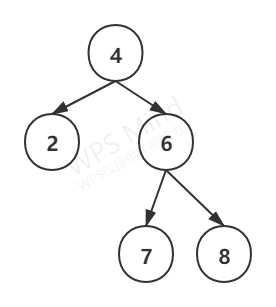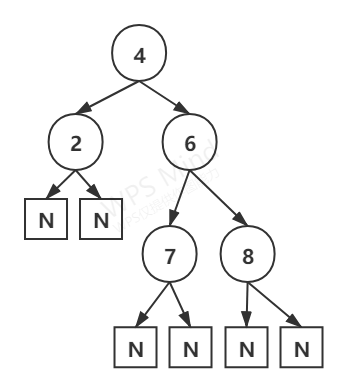题目描述
请实现两个函数,分别用来序列化和反序列化二叉树。
您需要确保二叉树可以序列化为字符串,并且可以将此字符串反序列化为原始树结构。
样例
你可以序列化如下的二叉树
8
/ \
12 2
/ \
6 4
为:"[8, 12, 2, null, null, 6, 4, null, null, null, null]"
算法1
1 树的中序前序后序遍历都可以访问到所有节点
但是无法得知节点在树的层级位置等信息
如图

但是如果我们使用满二叉树的格式来看待这颗树,不足的位置使用NULL来填充。

那么按照次序的遍历,是可以定位出该节点在树的位置。
2 接下来的问题是如何分割节点以及如何显示节点的数值和null节点
我采取的办法是#分割,N表示null节点,数值则直接转化成字符串即可
示例中的二叉树按照中序遍历转换最终可以转换成如下字符串
“#8#12#2#N#N#6#4#N#N#N#N#”
C++ 代码
/**
* Definition for a binary tree node.
* struct TreeNode {
* int val;
* TreeNode *left;
* TreeNode *right;
* TreeNode(int x) : val(x), left(NULL), right(NULL) {}
* };
*/
class Codec {
public:
void bfsTree(TreeNode* root,string& s){
if(root==NULL) { s+="N#";return; }
queue<TreeNode*> q;
q.push(root);
while(!q.empty()){
TreeNode* p = q.front(); q.pop();
if(p==NULL){ s+="N";s+="#";}
else { s+= to_string(p->val);s+="#";}
if(p!=NULL){
q.push(p->left);
q.push(p->right);
}
}
return;
}
// Encodes a tree to a single string.
string serialize(TreeNode* root) {
string ans = "#";
bfsTree(root,ans);
return ans;
}
TreeNode* GetNode(const string& data,int& idx)
{
int l = idx;
while(data[l]!='#'&& l< data.size()) l++;
int r =l+1;
while(data[r]!='#'&& r <data.size()) r++;
string str = data.substr(l+1,r-l-1);
idx =r;
if(str == "N") return NULL;
int val = atoi(str.c_str());
TreeNode* p = new TreeNode(val);
return p;
}
// Decodes your encoded data to tree.
TreeNode* deserialize(string data) {
cout<<data<<endl;
int idx = 0;
TreeNode* head = GetNode(data,idx);
if(head==NULL) return head;
queue<TreeNode*> q;
q.push(head);
while(!q.empty()){
TreeNode* p = q.front();q.pop();
if(p!=NULL){
p->left = GetNode(data,idx);
p->right = GetNode(data,idx);
q.push(p->left);
q.push(p->right);
}
}
return head;
}
};
// Your Codec object will be instantiated and called as such:
// Codec codec;
// codec.deserialize(codec.serialize(root));

